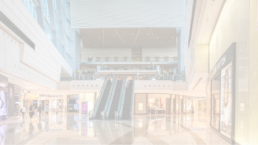Australian Shopfitting 101: Effective and Affordable Seasonal Shop Transformations for Valentine’s Day & Other Events
Shopfitting is an essential aspect of running a successful retail business. It involves the design and installation of fixtures, fittings, and displays in a store to create an attractive and functional space for customers. In Australia, shopfitting has gained significant importance due to the ever-changing consumer trends and the need for businesses to stay relevant in the competitive market. This article will explore the concept of shopfitting and how it can help retailers achieve effective and affordable display changes.

The Importance of Effective and Affordable Display Changes
In the fast-paced world of retail, businesses must adapt to changing seasons and trends. Effective and affordable display changes play a vital role in attracting customers, increasing sales, and creating a memorable shopping experience. By refreshing the look and feel of a store to align with different seasons, holidays, or events, retailers can create a sense of excitement and urgency among customers. This can lead to increased foot traffic, longer dwell times, and ultimately, higher conversion rates.
Understanding the Concept of Seasonal Store Transformations
Seasonal store transformations involve updating the store's layout, fixtures, and displays to reflect the changing seasons and associated themes. It allows retailers to create a visually appealing environment that resonates with customers and enhances their shopping experience. Whether it's the vibrant colors of spring, the cozy warmth of winter, or the romantic ambiance of Valentine's Day, seasonal displays can evoke emotions and attract attention. By tapping into the emotions and desires of their target audience, retailers can create a connection and drive sales.
Benefits of Quick Shop Fitouts
Quick shop fitouts are a cost-effective solution for retailers looking to make seasonal display changes without breaking the bank. These fitouts involve temporary modifications to the store's layout and fixtures, allowing for easy installation and removal. The flexibility of quick shop fitouts enables retailers to keep up with the fast-paced nature of seasonal changes without investing in permanent fixtures that may become obsolete in the future. It also provides an opportunity for experimentation and creativity, as retailers can easily switch between different display themes to test their effectiveness.
Cost-effective Retail Fitouts for Seasonal Displays
When it comes to seasonal displays, retailers need to strike a balance between effectiveness and affordability. Investing in high-quality, reusable fixtures and displays can help reduce long-term costs while maintaining a professional and visually appealing store environment. Additionally, leveraging cost-effective materials and creative design approaches can further enhance the impact of seasonal displays without breaking the budget. Retailers can explore options such as modular fixtures, lightweight materials, and DIY installation to achieve cost savings without compromising on quality.
Examples of Effective Seasonal Displays, like for Valentine's Day
Valentine's Day is a prime example of a seasonal event that retailers can leverage to create impactful displays. Retailers can create a romantic atmosphere by incorporating elements such as soft lighting, floral arrangements, and heart-shaped decorations. Displaying gift ideas and themed products prominently can also help customers find the perfect gift for their loved ones. By creating an immersive experience that appeals to the emotions associated with Valentine's Day, retailers can attract customers and increase sales during this season.

Shopfitting Tips for Creating Impactful Seasonal Displays
Creating impactful seasonal displays requires careful planning and execution. Here are some shopfitting tips to help retailers make the most out of their seasonal transformations:
- Understand your target audience: Research and understand the preferences and interests of your target audience to create displays that resonate with them.
- Tell a story: Create a narrative through your displays that engage customers and spark their imagination.
- Use lighting effectively: Proper lighting can enhance the visual appeal of displays and create a desired ambiance.
- Utilize signage and graphics: Clear signage and eye-catching graphics can attract attention and communicate key messages effectively.
- Ensure proper product placement: Position products strategically to guide customers' attention and encourage exploration.
- Regularly update displays: Keep your displays fresh and relevant by regularly updating them to align with the changing seasons and trends.
Finding the Right Shopfitting Solutions in Australia
To achieve effective and affordable display changes, retailers in Australia can turn to professional shopfitting services. These services specialize in creating customized shopfitting solutions tailored to the unique needs of each business. By partnering with experienced shopfitters, retailers can benefit from their expertise in design, project management, and installation. From concept development to execution, professional shopfitters ensure a seamless process that maximizes the impact of seasonal store transformations.
Hiring Professional Shopfitting Services for Seasonal Transformations
When it comes to seasonal transformations, hiring professional shopfitting services can provide retailers with numerous advantages. Professional shopfitters have access to a wide range of fixtures, fittings, and materials that can be customized to suit specific display requirements. They also possess the knowledge and skills to create visually appealing displays that align with the brand identity and target audience. Additionally, professional shopfitters can handle all aspects of the shopfitting process, including logistics, installation, and maintenance, allowing retailers to focus on their core business activities.

Elevate Your Retail Business with Australian Shopfitting
Effective and affordable display changes are essential for retailers to stay competitive in the ever-evolving retail landscape. Australian Shopfitting offers a range of solutions to help retailers transform their stores and create impactful seasonal displays. By understanding the concept of seasonal store transformations, leveraging quick shop fitouts, and incorporating cost-effective strategies, retailers can enhance their visual merchandising efforts without straining their budgets. Whether it's Valentine's Day or any other season, investing in professional shopfitting services can elevate the retail experience and drive business success.
Australian Shopfitting 101: How Long Does A Shop Fitout Truly Take?
Shopfitting plays a crucial role in creating an attractive and functional retail space. Whether it's a new store or a renovation, a well-executed shop fitout can significantly impact customer experience and ultimately contribute to the success of a business. In Australia, the shopfitting industry is thriving, with professionals specializing in designing and constructing retail spaces that align with the brand's vision and cater to the target market. However, one question that often arises is, "How long does a shop fitout truly take?"

What is a shop fitout and why is it important?
A shop fitout refers to the process of designing, planning, and constructing the interior of a retail store. It involves considering various elements such as layout, lighting, fixtures, signage, and overall aesthetics to create an inviting and functional space for customers. A well-designed shop fitout not only enhances the customer's experience but also showcases the brand's identity and products effectively. Businesses need to invest in a shop fitout as it can significantly influence customer behavior, increase sales, and create a positive brand image.
Factors that affect the duration of a shop fitout
Several factors can impact the duration of a shop fitout project in Australia. Firstly, the size and complexity of the store play a significant role. Larger stores or those with intricate designs may require more time for planning, construction, and installation of fixtures. Additionally, the availability of materials and equipment can affect the timeline. Delays in sourcing materials or equipment can result in project delays. The involvement of multiple contractors and tradespeople can also extend the duration of a shop fitout, as coordination between different parties may be required. Lastly, unforeseen challenges such as site restrictions, permit delays, or changes in design plans can also impact the overall timeline of a shop fitout project.
The shopfitting process: from planning to completion
A successful shop fitout project follows a systematic process, starting from the planning stage and ending with the completion of the construction. The first step is to establish the objectives and requirements of the store. This includes understanding the target market, brand identity, and desired customer experience. Once the objectives are clear, the design phase begins, where professionals create a layout, select materials, and plan the overall aesthetics. After design approval, the construction phase commences, involving the installation of fixtures, electrical work, painting, and other necessary construction tasks. Finally, the project is completed with final touches, such as signage installation and visual merchandising.
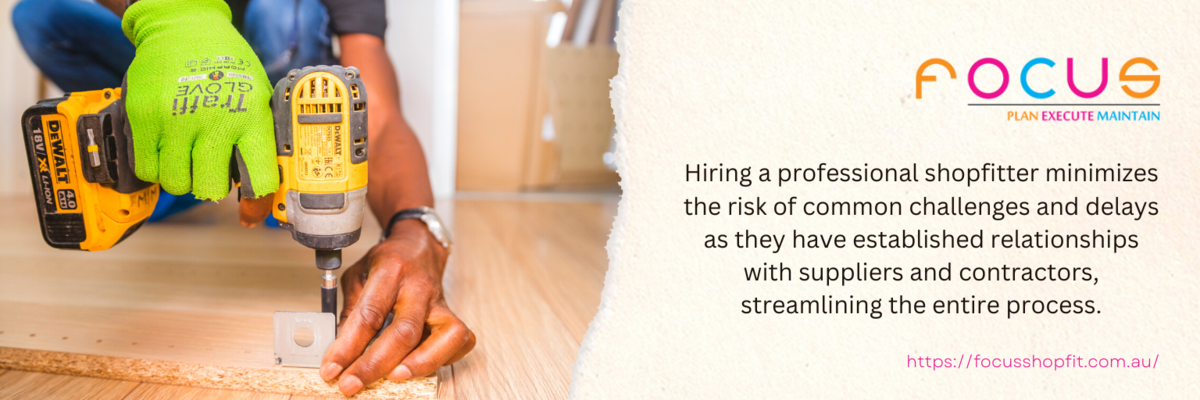
Tips for efficient shopfitting project management
Efficient project management is crucial for the timely completion of a shop fitout project. Here are some tips to ensure smooth progress:
- Clear communication: Maintain open and transparent communication channels with all stakeholders involved in the project, including contractors, suppliers, and the client.
- Detailed planning: Develop a comprehensive project plan that includes all tasks, timelines, and dependencies. Review and update the plan regularly with proper communication.
- Regular progress tracking: Monitor the progress of the project regularly, keeping a close eye on timelines, milestones, and any potential delays.
- Streamline decision-making: Establish clear decision-making processes to avoid unnecessary delays. Ensure that all parties involved are aware of their roles and responsibilities in making timely decisions.
- Collaborative approach: Foster a collaborative environment where all contractors and tradespeople work together seamlessly. Encourage regular communication and problem-solving.
Common challenges and delays in shopfitting projects
Despite careful planning and project management, shopfitting projects can face challenges and delays. Some common issues include:
- Permit delays: Obtaining necessary permits from local authorities can sometimes take longer than anticipated, leading to project delays.
- Changes in design plans: If there are any modifications or additions to the initial design plan, it can impact the timeline and require adjustments in construction.
- Unforeseen site restrictions: Discovering unexpected site restrictions or structural issues during the construction phase can lead to delays as additional work may be required to overcome these challenges.
- Material or equipment delays: Delays in the delivery of materials or equipment can halt the progress of the project. It is essential to have backup plans and alternative suppliers in case of such delays.
Hiring a professional shopfitting company in Australia
When embarking on a shop fitout project, it is recommended to hire a professional shopfitting company in Australia. These companies have the expertise, experience, and resources to manage shopfitting projects efficiently. They can provide valuable insights, and creative design solutions to ensure that the project stays on track and within the estimated timeframe. Hiring professionals also minimizes the risk of common challenges and delays as they have established relationships with suppliers and contractors, streamlining the entire process.

Factors to consider when estimating the duration of a shop fitout
Estimating the duration of a shop fitout involves considering various factors, including the size and complexity of the store, availability of materials and equipment, involvement of multiple contractors, and potential challenges or delays. On average, small to medium-sized retail stores can take 4 to 8 weeks, while larger and more intricate designs may require 8 to 12 weeks or more. Efficient project management, clear communication, and collaboration can help mitigate delays and ensure timely completion. By hiring a professional shopfitting company, businesses can benefit from their expertise and experience, resulting in a successful shop fitout that aligns with the brand's vision and enhances the customer's experience.
Australian Shopfitting 101: Effective Shopfitting On A Tight Budget
Shopfitting plays a crucial role in the success of Australian retailers. It involves designing and fitting out retail spaces to create an inviting environment that attracts customers and encourages them to make purchases. Effective shopfitting goes beyond aesthetics; it considers the functionality and layout of the store to optimize customer flow and enhance the overall shopping experience.

Australian retailers understand the significance of creating a visually appealing store that reflects their brand identity. Shopfitting allows them to showcase their products in the best possible way, enabling customers to easily find what they are looking for. It helps to establish a positive first impression and builds customer loyalty. In a competitive retail landscape, shopfitting can make a significant difference in attracting and retaining customers.
Understanding the concept of effective shopfitting
To achieve effective shopfitting, Australian retailers need to focus on a few key aspects. Firstly, they should have a clear understanding of their target market and tailor the store's design accordingly. The layout, color scheme, and overall ambiance should align with the preferences and needs of the intended customers.
Effective shopfitting requires careful consideration of the store's functionality. The placement of shelves, racks, and display units should be optimized to ensure easy navigation for customers. The flow of foot traffic should be smooth, leading customers through the store logically and intuitively.
A successful shopfitting project typically involves integrating technology and digital signage to enhance the shopping experience. Interactive displays, touchscreens, and mobile apps can provide customers with additional information about products, promotions, and loyalty programs. This not only engages customers but also provides retailers with valuable data for improving their marketing strategies.
Shopfitting on a tight budget: Is it possible?
Shopfitting can be a costly endeavor, especially for retailers on a tight budget. However, with careful planning and creativity, it is possible to achieve effective shopfitting without breaking the bank. Australian retailers need to prioritize their expenses and allocate their budget wisely to get the best results.
One approach is to focus on essential shopfitting elements that have the most impact on the overall store design. By investing in high-quality flooring, lighting, and signage, retailers can create a professional and inviting atmosphere. These elements set the foundation for a successful shopfitting project and can be complemented with more cost-effective solutions for other aspects.
Another cost-saving strategy is to consider pre-owned or refurbished fixtures and furniture. Many suppliers offer second-hand shopfitting items that are still in good condition. With proper cleaning and maintenance, these items can be a budget-friendly alternative to new fixtures. Additionally, retailers can explore local auctions or online marketplaces for discounted shopfitting materials.
Budget-friendly shopfitting strategies for Australian retailers
To achieve effective shopfitting on a tight budget, Australian retailers can employ various strategies. By adopting a creative and resourceful approach, retailers can create a visually appealing store without overspending.

Choosing cost-effective materials and fixtures for shopfitting
One key aspect of cost-effective shopfitting is selecting the right materials and fixtures. Retailers should prioritize durability and functionality while considering the cost. For example, laminate or vinyl flooring can be a more affordable alternative to hardwood or stone flooring, without compromising on aesthetics. Similarly, retailers can opt for modular shelving systems that offer flexibility and easy customization at a lower cost compared to custom-built shelves.
Creative shopfitting ideas for a tight budget
Creativity is essential when working with a limited budget. Retailers can explore innovative ideas to make the most of their available resources. For instance, repurposing old furniture or using unconventional materials such as pallets or crates can add a unique touch to the store's design. Retailers can also consider DIY projects for smaller fixtures or displays, which can save costs while adding a personal touch to the store.
DIY vs. professional shopfitting: Which is the better option for budget-conscious retailers?
The decision between DIY and professional shopfitting depends on various factors, including the complexity of the project, the retailer's expertise, and available resources. While DIY shopfitting can be a cost-saving option, it requires a significant investment of time and effort. Retailers need to have the necessary skills and knowledge to execute the project successfully. In contrast, professional shopfitters bring expertise and experience to the table, ensuring a seamless and efficient shopfitting process. They can provide valuable advice, access to suppliers, and professional installation services. Retailers should evaluate their circumstances and make an informed decision based on their budget and requirements.
Shopfitting mistakes to avoid when on a shoestring budget
While shopfitting on a tight budget is possible, Australian retailers should be mindful of common mistakes that can hinder the effectiveness of their efforts. One common mistake is overspending on unnecessary decorative elements or excessive branding. It's important to strike a balance between aesthetics and functionality, focusing on essential elements that create a positive shopping experience. Another mistake to avoid is neglecting maintenance and upkeep. Even with limited resources, retailers should allocate a portion of their budget for regular maintenance and repairs. This ensures that the shopfitting remains in good condition, maintaining its effectiveness and longevity.

Shopfitting on a shoestring - it's possible!
Effective shopfitting is essential for Australian retailers to create a visually appealing and functional store that attracts customers. While shopfitting can be a costly endeavor, it is possible to achieve great results on a tight budget. By prioritizing essential elements, considering cost-effective materials, and embracing creativity, retailers can create a successful shopfitting project without overspending. By learning from successful case studies and avoiding common mistakes, Australian retailers can achieve effective shopfitting that enhances their brand and drives customer engagement. So, embrace the challenge of shopfitting on a shoestring budget and create a store that stands out in the competitive retail landscape.
Australian Shopfitting 101: Cost of Shopfitting and ROI Considerations
Shopfitting plays a crucial role in the success of any retail business in Australia. It involves the design, construction, and installation of fixtures, fittings, and furniture that make a store visually appealing and functional. In a highly competitive market, shopfitting is a way for businesses to create a unique and attractive space that attracts customers and enhances the overall shopping experience. This article delves into the cost of shopfitting in Australia and the return on investment (ROI) considerations for businesses.

Importance of shopfitting for businesses
In the competitive retail landscape of Australia, shopfitting is more than just creating a visually appealing store. It is about creating a unique brand identity, enhancing customer experience, and maximizing sales potential. A thoughtfully designed shopfitting can create a lasting impression on customers, differentiate a business from its competitors, and drive customer loyalty. It is an investment that can lead to increased footfall, higher conversion rates, and ultimately, higher profits.
Shopfitting also plays a crucial role in creating a seamless and efficient store layout. A well-designed store layout can enhance customer flow, improve product visibility, and optimize the use of available space. This, in turn, can lead to increased sales and improved operational efficiency.
Factors Affecting Shopfitting Costs in Australia
The cost of shopfitting in Australia can vary significantly depending on several factors. Some of the key factors that influence the overall cost include:
Size and complexity of the store:
The size and complexity of the store are major determinants of the shopfitting cost. Larger stores require more materials and labor, which can drive up the overall cost. Similarly, stores with intricate designs or unique requirements may require specialized expertise, resulting in higher costs.
Quality of materials and finishes:
The choice of materials and finishes used in shopfitting can greatly impact the cost. Premium materials and finishes tend to be more expensive but can also create a more luxurious and high-end look. On the other hand, cost-effective materials can help keep the budget in check without compromising on functionality and aesthetics.
Customization and branding requirements:
If a business requires custom fixtures, fittings, or branding elements, the cost of shopfitting may increase. Customization often involves additional design and manufacturing processes, which can add to the overall cost. However, it also allows businesses to create a unique and cohesive brand image that resonates with their target audience.
Location:
The location of the store can also affect the cost of shopfitting. Certain areas may have higher labor costs or specific regulatory requirements that need to be considered during the shopfitting process. It is essential to factor in these location-specific considerations when budgeting for shopfitting.
Shopfitting costs in Australia: getting accurate estimates
Businesses should consult with professional shopfitting companies to get accurate cost estimates based on their unique needs and specifications. A reliable shopfitting company will provide a detailed breakdown of costs, helping businesses make informed decisions and avoid unexpected budget overruns.
Calculating the return on investment (ROI) of shopfitting
While shopfitting is an investment for businesses, it is essential to evaluate the return on investment (ROI) to determine its effectiveness. Calculating the ROI of shopfitting involves considering the increase in sales, customer satisfaction, and brand value resulting from the project.
To calculate the ROI, businesses can compare the pre-shopfitting and post-shopfitting sales figures, taking into account any increase in revenue. Additionally, customer feedback and satisfaction surveys can provide valuable insights into the impact of shopfitting on customer experience. Businesses can also assess the brand value and recognition generated through the shopfitting project.
By analyzing these factors, businesses can determine the overall impact of shopfitting on their bottom line and make informed decisions about future investments in improving stores.
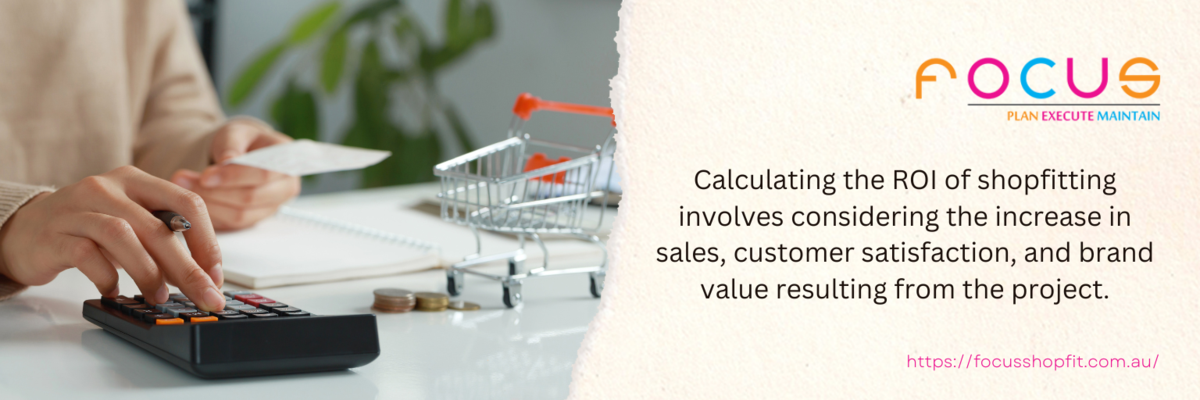
Tips for maximizing profits through effective shopfitting
To maximize profits through effective shopfitting, businesses can consider the following tips:
Understand your target audience:
Before embarking on a shopfitting project, it is crucial to have a deep understanding of the target audience. This will help in creating a store environment that resonates with their preferences and expectations.
Focus on functionality:
While aesthetics are important, ensuring the store layout and fixtures are functional is equally crucial. A well-designed store layout can enhance customer flow, improve product visibility, and optimize space utilization.
Incorporate branding elements:
Integrating branding elements into the shopfitting design can create a cohesive brand image and reinforce brand identity. Consistent branding throughout the store can help in building brand recognition and customer loyalty.
Embrace technology:
Leveraging technology in shopfitting can enhance the overall customer experience. Interactive displays, digital signage, and virtual reality elements can engage customers and create a memorable shopping experience.
Regular maintenance and updates:
To ensure the shopfitting remains effective in the long run, regular maintenance and updates are essential. This includes keeping the store clean, fixing any damages, and refreshing the store design periodically to stay relevant and appealing to customers.
Choosing the right shopfitting company in Australia
Selecting the right shopfitting company is crucial for a successful project. When choosing a shopfitting company in Australia, businesses should consider the following factors:
Experience and expertise:
Look for a shopfitting company with a proven track record and extensive experience in the industry. An experienced company will have the knowledge and skills to handle complex projects and deliver high-quality results.
Portfolio:
Review the company's portfolio and ask feedback from previous clients. This will give businesses an idea of the company's capabilities and the satisfaction level of their past clients.
Customization capabilities:
If businesses have specific customization requirements, ensure that the shopfitting company can deliver tailored solutions. Discuss the customization options and assess the company's ability to meet unique project needs.
Budget and timeline:
Discuss the budget and timeline requirements with the shopfitting company upfront. A reliable company will provide a detailed cost breakdown and a realistic timeline for the project.
Communication and collaboration:
Effective communication and collaboration are essential for a successful shopfitting project. Choose a shopfitting company that values open communication and is willing to work closely with the business to achieve the desired outcomes.

Investing in shopfitting for long-term success
Shopfitting is a critical investment for businesses in Australia. It not only enhances the visual appeal of a store but also creates a unique brand identity and improves the overall customer experience. While the cost of shopfitting can vary depending on various factors, businesses can expect a significant return on investment through increased sales, customer satisfaction, and brand recognition. By following the tips mentioned in this article and choosing the right shopfitting company, businesses can maximize the profits generated from effective shopfitting projects.
Australian Shopfitting 101: How A Shopfitter Can Help Make The Best Use Of Store Space
Shopfitting plays a vital role in creating an inviting and functional retail environment. In Australia, shopfitting has become an essential aspect of retail design and construction. Shopfitters are professionals who specialize in maximizing store space and creating an appealing layout that attracts customers. This article is about the significance of shopfitting in the Australian retail industry and explores how shopfitters can help businesses make the best use of their store space.
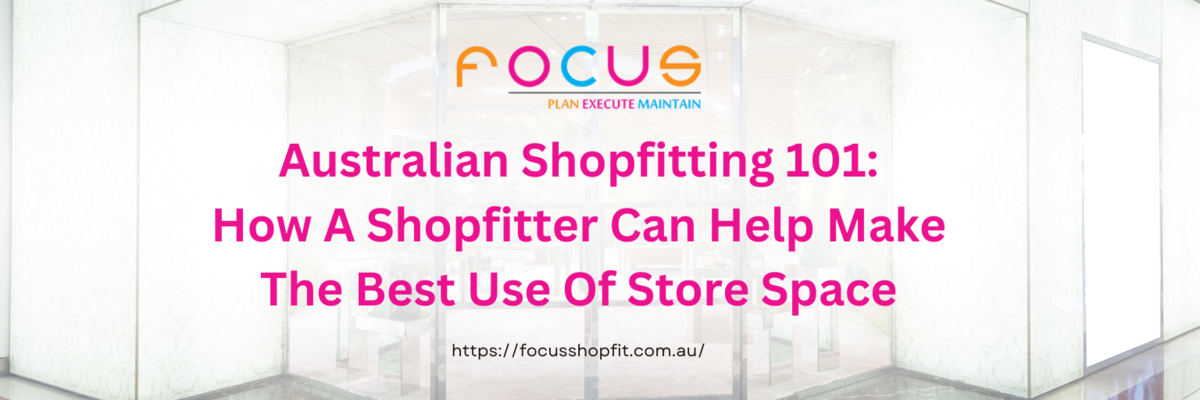
The role of a shopfitter in maximizing store space
A shopfitter's primary objective is to optimize store space efficiently. They possess the expertise to analyze the available area and develop innovative solutions to make the most of it. Shopfitters understand the psychology of consumer behavior and use this knowledge to create layouts that enhance the overall shopping experience. By integrating elements such as aisle width, product placement, and signage, shopfitters can guide customers through the store and strategically display merchandise, ultimately leading to increased sales.
Shopfitters also consider the flow of foot traffic within the store. They ensure that the layout is easy to navigate, with clearly defined pathways that direct customers towards high-demand areas. Efficient space utilization can result in improved customer satisfaction, increased dwell time, and ultimately, higher conversion rates.
Benefits of hiring a professional shopfitter
Hiring a professional shopfitter brings numerous benefits to retailers. Firstly, shopfitters have extensive knowledge and experience in the field. They stay updated with the latest industry trends, regulations, and materials, ensuring that the store design is contemporary and compliant. Retailers can leverage their expertise to create a visually appealing and functional space that aligns with their brand identity.
Additionally, shopfitters have access to a wide network of suppliers and contractors. They can source high-quality materials at competitive prices, providing retailers with cost-effective solutions. Moreover, shopfitters oversee the entire shopfitting process, coordinating with various tradespeople to ensure that the project is completed on time and within budget.
By hiring a professional shopfitter, retailers can save valuable time and resources while achieving optimal store space utilization.
Common challenges in store space utilization
Despite the importance of efficient store space utilization, retailers often face common challenges. Limited square footage, irregular store layouts, and existing architectural constraints can pose significant obstacles. It is crucial to address these challenges to maximize the potential of the available space.
A professional shopfitter can help overcome these challenges by conducting a thorough analysis of the store and developing tailored strategies. They can utilize innovative techniques to create a seamless flow, regardless of the store's shape or size. By optimizing shelving systems, utilizing vertical space, and incorporating modular fixtures, shopfitters can transform even the most challenging spaces into functional and visually appealing environments.
Shopfitting techniques to optimize store space
Shopfitters employ various techniques to optimize store space and create an efficient layout. One technique is the use of modular fixtures and flexible displays. These can be easily rearranged to accommodate changing product assortments and seasonal displays. By incorporating movable fixtures, shopfitters can adapt the store layout to meet evolving business needs.
Another effective technique is the implementation of vertical storage solutions. Utilizing vertical space not only maximizes store capacity but also enhances visual merchandising opportunities. Shopfitters can install high shelving units, mezzanines, or hanging systems to display merchandise effectively, making use of every available inch of space.
Additionally, shopfitters focus on creating effective aisle layouts. By strategically placing aisles and adjusting their width, shopfitters can control the flow of foot traffic and guide customers toward specific areas of the store. This technique ensures that no space is wasted and that customers have a seamless shopping experience.
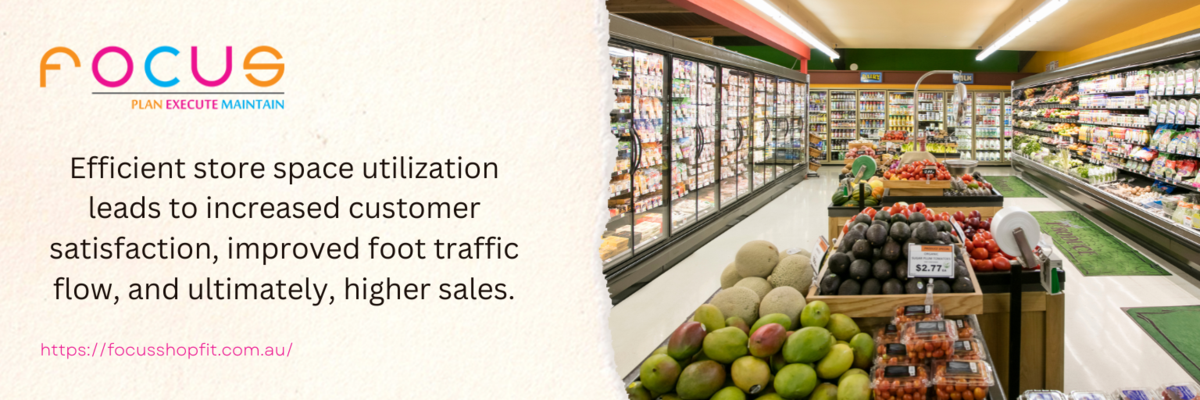
Factors to consider when choosing a shopfitter
When selecting a shopfitter, several factors should be taken into consideration. Firstly, it is essential to evaluate the shopfitter's experience and expertise in the retail industry. A shopfitter with a proven track record of successful projects and a deep understanding of store space optimization is more likely to deliver satisfactory results.
It is also crucial to assess the shopfitter's ability to understand and align with the retailer's brand identity. Effective communication and collaboration between the retailer and shopfitter are essential for creating a store environment that accurately represents the brand and appeals to the target audience.
Furthermore, it is recommended to ask for references and testimonials from previous clients. This will provide insights into the shopfitter's professionalism, reliability, and ability to meet deadlines and budgets.
Shopfitting services in Australia
Australia offers a wide range of shopfitting services, catering to the diverse needs of retailers. From boutique stores to large-scale supermarkets, shopfitters specialize in various sectors to provide tailored solutions.
Many shopfitters in Australia offer comprehensive services, including design, construction, project management, and maintenance. These full-service shopfitters streamline the shopfitting process, ensuring that all aspects of the project are efficiently executed.
Retailers can also find specialized shopfitters who focus on specific areas such as visual merchandising, lighting design, or custom fixtures. These niche shopfitters bring unique expertise to the table, enabling retailers to create a customized and visually impactful store environment.
The importance of shopfitting in creating a successful retail environment
In conclusion, shopfitting plays a crucial role in maximizing store space and creating successful retail environments. Australian shopfitters possess the expertise to optimize store layouts and create visually appealing and functional spaces. By hiring a professional shopfitter, retailers can benefit from their experience, access to resources, and ability to overcome common challenges.
Efficient store space utilization leads to increased customer satisfaction, improved foot traffic flow, and ultimately, higher sales. Shopfitters employ various techniques, such as modular fixtures, vertical storage solutions, and strategic aisle layouts, to make the best use of available space. Successful case studies in Australia demonstrate the effectiveness of professional shopfitting in transforming stores and achieving tangible results.
When choosing a shopfitter, retailers should consider factors such as experience, compatibility with brand identity, and references from previous clients. Australia offers a diverse range of shopfitting services, from full-service providers to specialized niche shopfitters.

While the cost of shopfitting may vary, the long-term return on investment justifies the expenditure. By investing in professional shopfitting, retailers can create a retail environment that attracts customers, enhances their shopping experience, and contributes to the overall success of the business.
Australian Shopfitting 101: How Can A Professional Shopfitter Help Develop Your Brand Identity?
In the competitive world of retail, creating a strong brand identity is essential for success. One key aspect of building a brand identity is through effective shopfitting. In Australia, shopfitting plays a crucial role in attracting customers and creating a memorable shopping experience. This article will explore the importance of brand identity, what a professional shopfitter does, and how they can help enhance your brand identity.

The Importance of Brand Identity
Brand identity is the unique representation of a brand through various visual and sensory elements. It encompasses the brand's values, personality, and positioning in the market. A strong brand identity not only helps customers recognize and differentiate a brand from its competitors but also establishes an emotional connection with them. It is a powerful tool that can influence consumer behavior and drive brand loyalty.
What is a Professional Shopfitter?
A professional shopfitter is a skilled individual or company that specializes in designing and constructing retail spaces. They work closely with retailers to understand their brand identity and create a physical environment that reflects it. From the layout and fixtures to the lighting and signage, a professional shopfitter ensures that every element of the store aligns with the brand's image and values.
How a Professional Shopfitter Can Enhance Your Brand Identity
A professional shopfitter brings expertise and experience to the table, helping retailers develop and enhance their brand identity through effective shopfitting. They understand the importance of creating a cohesive and immersive shopping experience that resonates with customers. By utilizing their knowledge of design principles, consumer behavior, and industry trends, they can transform a retail space into a powerful brand statement.
One way a professional shopfitter enhances brand identity is through careful selection of materials, colors, and finishes. They consider the brand's aesthetics and target audience to create a harmonious and visually appealing environment. For example, if a brand aims to convey a luxurious and high-end image, the shopfitter may use premium materials such as marble and brass accents to create an upscale atmosphere.
In addition to aesthetics, a professional shopfitter also focuses on functionality and practicality. They ensure that the store layout facilitates smooth customer flow, maximizes product visibility, and provides a comfortable shopping experience. By optimizing the space and considering factors such as accessibility and ergonomics, they create an environment that aligns with the brand's values and enhances the overall brand experience.

Understanding the Shopfitting Process
The shopfitting process involves several stages, each crucial for developing a brand identity. It starts with a thorough understanding of the brand's objectives, target market, and positioning. The shopfitter conducts a detailed analysis of the brand's values, aesthetics, and customer preferences to inform the design and construction process.
Next, the shopfitter develops a comprehensive design concept that aligns with the brand's identity. This includes creating floor plans, 3D renderings, and mood boards to visualize the outcome. The design concept takes into account factors such as product display, signage, lighting, and customer flow to create a cohesive and engaging space.
Once the design is approved, the shopfitter begins the construction phase. This involves sourcing materials, coordinating with contractors, and overseeing the installation of fixtures, fittings, and other elements. A professional shopfitter ensures that every aspect of the project is executed with precision and attention to detail, resulting in a seamless and visually stunning retail space.
Key Considerations when Hiring a Professional Shopfitter
When hiring a professional shopfitter, it is important to consider several key factors to ensure a successful collaboration. Firstly, look for a shopfitter with experience in your industry or similar projects. They should have a portfolio that showcases their ability to create diverse and impactful retail spaces.
Secondly, communication is crucial. A professional shopfitter should be an excellent listener and communicator, able to understand and interpret your brand's vision accurately. Regular communication and updates throughout the project ensure that any issues or changes can be addressed promptly.
Lastly, consider the shopfitter's reputation and client testimonials. A reliable and reputable shopfitter will have positive reviews from previous clients, indicating their professionalism, quality of work, and ability to meet deadlines.
Benefits of Investing in Professional Shopfitting for Your Brand
Investing in professional shopfitting offers several benefits for your brand's identity and overall success. Firstly, it helps create a memorable and unique shopping experience that sets your brand apart from competitors. A well-designed and thoughtfully executed retail space can leave a lasting impression on customers, leading to increased brand recognition and loyalty.
Secondly, professional shopfitting maximizes the potential of your retail space. By optimizing the layout, fixtures, and displays, a shopfitter can enhance product visibility and encourage customer engagement. This ultimately drives sales and boosts your brand's profitability.
Lastly, professional shopfitting ensures consistency across multiple store locations. If you have a chain of stores, maintaining a consistent brand identity is crucial. A professional shopfitter can develop a design template that can be replicated across different locations while customizing elements to suit each specific store's needs.

Elevate Your Brand Identity with Professional Shopfitting
In the dynamic world of retail, a strong brand identity is vital for success. Professional shopfitting plays a crucial role in developing and enhancing that brand identity. By working with a skilled shopfitter, you can create a retail space that reflects your brand's values, engages customers, and leaves a lasting impression. Invest in professional shopfitting and elevate your brand identity to new heights.
Australian Shopfitting 101: How is Effective Shopfitting Done?
Shopfitting is a crucial aspect of establishing a successful retail business in Australia. It involves the design, construction, and installation of fixtures, fittings, and equipment to create an attractive and functional retail space. Effective shopfitting goes beyond just aesthetics; it aims to optimize the layout and design of a store to enhance customer experience, promote sales, and reflect the brand identity. This article explores the importance of effective shopfitting, the latest trends in Australia, and the process of a retail fit-out, and provides valuable tips for both small business owners and larger enterprises.

The Importance of Effective Shopfitting
Effective shopfitting plays a fundamental role in the success of a retail business. It creates a visually appealing environment that attracts customers and encourages them to explore the store further. A well-designed shopfitting layout optimizes the use of space, ensuring that products are displayed in an organized and accessible manner. This enhances the overall shopping experience for customers, making them more likely to make a purchase and return for future visits.
Furthermore, effective shopfitting helps to establish the brand identity and personality of a business. Through thoughtful design choices, the shopfitting can convey the values, style, and ethos of the brand, creating a cohesive and memorable shopping experience. This is particularly important in a competitive market like Australia, where consumers are increasingly seeking unique and immersive retail experiences.
Choosing the Right Shopfitter for Your Business
Selecting the right shopfitter is crucial for the success of your retail business. It is important to consider their experience, expertise, and portfolio of previous projects. Look for a shopfitter who understands your brand identity and can translate it into a visually compelling store design. Additionally, ensure that they have a strong understanding of the retail industry in Australia and are up-to-date with the latest shopfitting trends.
Communication is key when working with a shopfitter. It is essential to have a clear and open line of communication to discuss your requirements, timelines, and budget constraints. A professional shopfitter should be able to provide detailed plans, 3D renderings, and cost estimates to give you a comprehensive understanding of the project scope.
The Process of a Retail Fit-Out
A retail fit-out involves several stages, from the initial concept design to the final installation. It typically begins with a thorough analysis of the retail space, including measurements, existing fixtures, and infrastructure. This is followed by the creation of a design concept that aligns with the brand and business objectives. The shopfitter will then develop detailed plans, including floor layouts, lighting design, and fixture specifications.
Once the fit-out design is finalized, the construction phase begins. This involves the fabrication of fixtures, installation of electrical and plumbing systems, and the construction of walls, ceilings, and flooring. The shopfitter manages the entire process, ensuring that the project progresses smoothly and adheres to the agreed-upon timeline.
After the construction is completed, the shopfitting company will conduct a thorough inspection to ensure that everything is in place and functioning correctly. They will make any necessary adjustments and provide training on the operation and maintenance of the shopfitting elements. Finally, the shopfitter will hand over the completed retail space to the business owner, ready for operation.
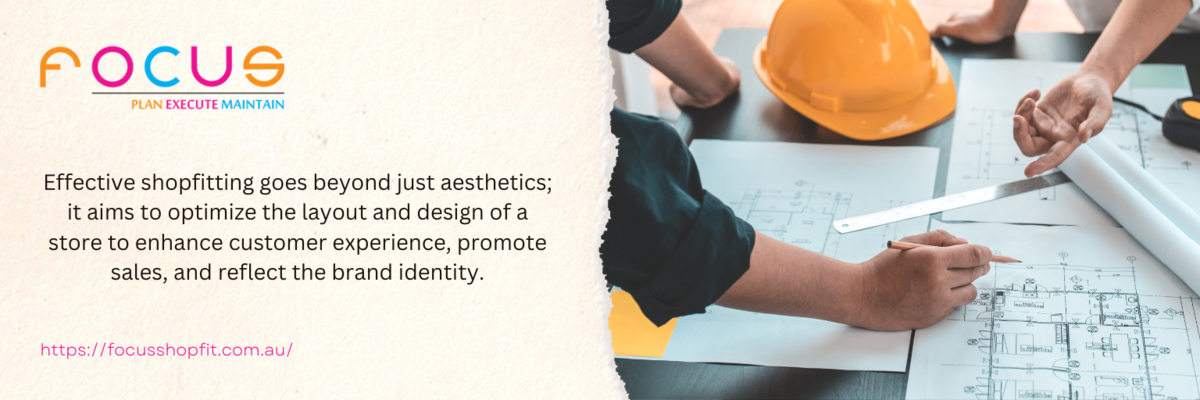
Elements of Effective Shopfitting
Effective shopfitting involves a careful consideration of various elements to create a cohesive and functional retail space. Lighting plays an essential role in setting the mood and highlighting products in your store. The use of different lighting techniques, such as ambient, accent, and task lighting, can create an inviting and visually appealing atmosphere.
Another essential element is the use of fixtures and fittings. These include shelving, display units, and racks that allow for the effective presentation of products. The shopfitter will consider factors such as product visibility, accessibility, and space optimization when designing the layout of fixtures.
The choice of materials and finishes also contributes to effective shopfitting. High-quality materials enhance the aesthetic and ensure the durability and longevity of your store. From flooring options to wall finishes, selecting materials that align with the brand and the desired shopping experience is crucial.
Shopfitting Materials and Finishes
In Australia, shopfitters have access to a wide range of materials and finishes to suit different retail concepts and budgets. Timber is a popular choice for its warm and natural appeal. It can be used for flooring, display units, and even feature walls. Metal finishes, such as stainless steel and brass, provide a modern and industrial look. They are often used for fixtures and fittings, adding a touch of sophistication to the retail space.
When it comes to flooring, options range from polished concrete for a contemporary feel to luxurious carpets for a more upscale environment. The selection of wall finishes varies from paint and wallpaper to textured panels and decorative cladding. Each material and finish choice should be carefully considered to create a cohesive and visually pleasing shopfitting design.
Shopfitting Tips for Small Businesses
Effective shopfitting is not limited to large retail chains; small businesses can also create impactful and inviting retail spaces. Here are some tips for small business owners:
- Define your brand identity: Understand your brand's values, target audience, and unique selling points. This will guide your shopfitting choices and ensure consistency throughout the store.
- Optimize the use of space: Small retail spaces require efficient use of every square foot. Consider versatile fixtures, such as modular shelving and adjustable display units, to maximize product visibility.
- Create focal points: Draw attention to key products or promotions by creating eye-catching displays or feature walls. This will capture customers' attention and encourage them to explore further.
- Pay attention to signage: Clear and well-designed signage helps customers navigate your store and find what they are looking for. Use consistent branding and legible fonts to ensure a cohesive visual identity.
- Keep it organized: A cluttered or disorganized store can deter customers. Regularly evaluate your shopfitting layout to ensure products are organized, shelves are well-stocked, and the space is tidy.
Hiring a Professional Shopfitting Company
For businesses seeking a seamless and professional shopfitting experience, it is essential to hire a reputable shopfitting company. Choose a shopfitting company with a proven track record, positive testimonials from previous clients, and a portfolio that aligns with your vision. Request detailed proposals and cost estimates from multiple companies to ensure you find the best fit for your business.
When hiring a shopfitting company, consider their expertise in retail fit-outs, knowledge of Australian regulations and standards, and ability to meet deadlines. A professional shopfitter will provide a comprehensive service, from concept design to final installation, ensuring that your retail space is transformed into a visually appealing and functional environment.

Effective shopfitting is a critical factor in the success of any retail business in Australia. It goes beyond aesthetics and aims to create a visually appealing and functional retail space that enhances the customer experience and reflects the brand identity. By understanding the importance of effective shopfitting, staying informed about the latest trends, and hiring a professional shopfitting company, businesses can create memorable and profitable retail environments. Whether you are a small business owner or part of a larger enterprise, investing in effective shopfitting is an investment in the future success of your business.
Australian Shopfitting 101: Is it Time to Hire a Shopfitter? Signs Your Retail Space Needs a Professional Touch
In today's competitive retail landscape, businesses must create an inviting and visually appealing space for their customers. One way to achieve this is by hiring a professional shopfitter. A shopfitter is a specialist who designs, plans, and installs fixtures, fittings, and displays in retail spaces. They have the expertise and knowledge to transform a dull and uninspiring store into a captivating and functional space that attracts customers. In this article, we will explore the signs that indicate your retail space needs a shopfitter, the benefits of hiring one, how to find the right shopfitter for your business, the shopfitting process, popular shopfitting trends and design ideas, costs, and budgeting tips, common shopfitting mistakes to avoid, and successful shopfitting case studies.

What is a Shopfitter and What Do They Do?
Before diving into the signs that indicate the need for a shopfitter, it is important to understand what exactly a shopfitter does. A shopfitter is a professional who specializes in the design, installation, and renovation of retail spaces. They work closely with business owners to understand their brand, target customers, and goals to create a customized space that aligns with their vision.
Shopfitters are skilled in various areas including interior design, carpentry, electrical work, plumbing, and project management. They are responsible for planning the layout of the store, sourcing and installing fixtures and fittings, ensuring compliance with building regulations, and creating a cohesive and visually appealing environment that enhances the customer experience.
Signs That Your Retail Space Needs a Shopfitter
Several signs indicate your retail space may benefit from the expertise of a shopfitter. One of the most obvious signs is if your store looks outdated and fails to attract customers. If your fixtures and fittings are old, worn out, or no longer align with your brand, it may be time for a refresh. A shopfitter can transform your space by replacing outdated fixtures with modern and functional ones that create a positive first impression on customers.
Another sign is if your store lacks organization and efficient use of space. A shopfitter can help optimize the layout of your store, ensuring that products are displayed appealingly and logically. They can create custom shelving and displays that maximize available space and make it easier for customers to navigate and find what they are looking for.
Additionally, if your store experiences frequent maintenance issues such as electrical problems or plumbing leaks, it may be a sign that the infrastructure needs attention. A shopfitter can assess the existing infrastructure and make necessary repairs or upgrades to ensure your store operates smoothly and safely.
Benefits of Hiring a Shopfitter
Hiring a shopfitter offers numerous benefits for retail businesses. Firstly, a professional shopfitter has the knowledge and experience to create a visually stunning and functional space that appeals to customers. They understand the psychology of consumer behavior and can design the layout and displays in a way that encourages browsing, engagement, and ultimately, purchases.
Secondly, a shopfitter can save business owners time and stress by managing the entire shopfitting process from start to finish. They have a network of trusted suppliers and contractors, ensuring that the project runs smoothly and on schedule. This allows business owners to focus on other aspects of their operations without the added burden of overseeing a complex renovation or installation.
Furthermore, a well-designed retail space can enhance the perceived value of products and services. Customers are more likely to perceive a business as professional, trustworthy, and of higher quality if the physical environment reflects these attributes. A shopfitter can help create a brand identity and atmosphere that resonates with your target audience, increasing customer loyalty and sales.

How to Find the Right Shopfitter for Your Business
Finding the right shopfitter for your business is crucial to the success of your shopfitting project. Here are some steps to help you find the perfect fit:
- Research and Recommendations: Start by conducting thorough research and gathering recommendations from other business owners in your industry. Look for shopfitters with a proven track record and positive reviews.
- Portfolio and Experience: Review the portfolios and previous work of potential shopfitters to ensure they have experience in projects similar to yours. This will give a general idea of the range of their design style and capabilities.
- Meetings and Interviews: Schedule meetings with shortlisted shopfitters to discuss your project in detail. Ask about their process, timelines, and any specific requirements you may have. This will help you measure the level of professionalism as well as their communication skills.
- References and Testimonials: Request references from previous clients and follow up with them to get a better understanding of the shopfitter's reliability and quality of work.
- Cost and Budget: Obtain detailed quotes from multiple shopfitters and compare them based on the scope of work, materials used, and timeline. Remember to consider both the upfront cost and the long-term value the shopfitter can bring to your business.
By following these steps and carefully evaluating your options, you can find a shopfitter who understands your vision, has the necessary expertise, and fits within your budget.
Shopfitting Mistakes to Avoid
While shopfitting can greatly benefit your retail business, there are common mistakes that can hinder the success of your project. Here are some mistakes to avoid:
- Lack of Planning: Failing to plan and define your goals before starting the shopfitting process can lead to costly changes and delays. Take the time to thoroughly plan and communicate your vision to the shopfitter.
- Ignoring Regulations: Ensure that your shopfitting project complies with local building regulations, fire safety codes, and accessibility standards. Failure to do so can result in fines, delays, or even closure of your business.
- Poor Lighting: Inadequate or poorly placed lighting can negatively impact the overall ambiance and visibility of your products. Invest in proper lighting design to enhance the aesthetics and functionality of your space.
- Overlooking Maintenance: Plan for regular maintenance and upkeep of your shopfitting installations. Ignoring maintenance can lead to premature wear and tear, compromising the functionality and appearance of your retail space.
- Ignoring Customer Feedback: Listen to your customers and take their feedback into account when designing or renovating your retail space. They are the ones who will ultimately determine the success of your shopfitting project.
By avoiding these common mistakes and working closely with your shopfitter, you can ensure a smooth and successful shopfitting project that maximizes the potential of your retail space.
Making the Decision to Hire a Shopfitter
Hiring a shopfitter can greatly enhance the success of your retail business by creating an inviting and functional space that attracts customers. By recognizing the signs that indicate the need for a shopfitter, understanding the benefits they offer, and following the steps to find the right shopfitter for your business, you can embark on a shopfitting project that transforms your retail space into a thriving environment.

Remember to consider shopfitting trends and design ideas, carefully manage your budget, and avoid common mistakes to ensure a successful outcome. By working closely with your shopfitter and incorporating their expertise, you can create a memorable shopping experience for your customers and increase your chances of long-term success in the competitive retail industry.
Building Success: How Australian Shopfitting Services Can Transform Your Business
Shopfitting is a crucial aspect of any business, as it involves designing and organizing the interior of a retail space to create an appealing and functional environment for customers. In Australia, the shopfitting industry has evolved significantly over the years, offering a wide range of services to businesses across various sectors. Australian shopfitting services have gained recognition for their expertise, professionalism, and ability to transform businesses into thriving success stories.

The Importance of Shopfitting for Businesses
Shopfitting plays a vital role in the success of a business. When customers step into a retail space, they form an impression within seconds. Australian shopfitting services understand this and work diligently to create an environment that reflects the brand's identity, attracts customers, and enhances the overall shopping experience. A well-designed shopfitting can significantly impact a business's sales, customer satisfaction, and brand reputation.
A professionally designed and executed shopfitting communicates a sense of trust, professionalism, and attention to detail, which can help businesses stand out from their competitors. From the layout and placement of merchandise to lighting, signage, and even the choice of materials, every aspect of shopfitting is carefully curated to create a cohesive and visually appealing space that engages customers and encourages them to explore more.
Benefits of Hiring Australian Shopfitting Services
Engaging Australian shopfitting services can provide numerous benefits for businesses. Firstly, these services have a deep understanding of the Australian market and can tailor the shopfitting design to suit local preferences and trends. By staying updated with the latest industry standards and design practices, Australian shopfitters can ensure that businesses stay ahead of the curve and provide customers with a modern and visually appealing shopping experience.
Australian shopfitting services often have a network of reliable suppliers, contractors, and tradespeople who can assist in the shopfitting process. This ensures that businesses receive high-quality materials, craftsmanship, and timely execution of the project. With their expertise and experience, Australian shopfitters can also offer valuable advice and insights, helping businesses make informed decisions about design, layout, and overall functionality.
How Australian Shopfitting Services Can Transform Your Business
Australian shopfitting services have the potential to transform businesses in various ways. Firstly, a well-executed shopfitting can optimize the use of available space, ensuring that every inch is utilized effectively. By strategically placing shelves, displays, and fixtures, shopfitters can enhance product visibility, encourage customer flow, and maximize sales potential. This can lead to increased revenue and improved overall business performance.
Moreover, Australian shopfitting services focus on creating a cohesive and immersive brand experience. By incorporating brand elements, colors, and themes into the shopfitting design, businesses can reinforce their brand identity and create a memorable impression on customers. This not only helps in building brand loyalty but also increases the chances of customers recommending the business to others.
Additionally, they can enhance the functionality of a retail space. Australian shopfitters consider factors such as customer comfort, accessibility, and safety to create an environment that is easy to navigate and enjoyable to spend time in. A well-designed shopfitting can also improve staff efficiency by providing them with ergonomic workstations, storage solutions, and an organized layout, resulting in improved productivity and customer service.

The Process of Shopfitting
The shopfitting process typically involves several stages, starting with an initial consultation and assessment of the business's requirements and objectives. Australian shopfitters collaborate closely with businesses to understand their brand vision, target audience, and budget constraints. This information guides the shopfitters in creating a customized plan and design proposal that aligns with the business's goals.
Once the design is finalized, the shopfitting team begins the execution phase, which includes procuring materials, coordinating with contractors, and overseeing the construction and installation process. These shopfitting services ensure that the project is completed within the agreed timelines, adhering to quality standards and regulatory requirements. Throughout the process, open communication channels are maintained to keep businesses informed about the progress and address any concerns.
After the construction is complete, Australian shopfitting services conduct thorough inspections and quality checks to ensure that everything is functioning as intended. They also provide after-sales support and maintenance services, ensuring that businesses can rely on their shopfitting for the long term.
Factors to Consider When Choosing Australian Shopfitting Services
When selecting shopfitting services, businesses should consider several factors to make an informed decision. Firstly, it is essential to assess the experience and expertise of the shopfitting company. A reputable Australian shopfitting service will have a portfolio of successful projects, testimonials, and industry certifications that demonstrate their capabilities.
It is also crucial to consider the shopfitting company's ability to understand and align with the business's brand identity and values. Clear communication and collaboration are very important factors for success in shopfitting. Businesses should also evaluate the shopfitting company's ability to work within the given budget and timeline, ensuring that there are no unexpected delays or cost overruns.
Furthermore, businesses should inquire about the shopfitting company's knowledge of industry trends, regulations, and sustainability practices. Adhering to environmental standards and incorporating sustainable materials and practices can not only benefit the planet but also enhance a business's reputation and appeal to environmentally conscious customers.

Why Australian Shopfitting Services Are Essential for Business Success
Australian shopfitting services have proven to be instrumental in transforming businesses and driving success. From creating visually appealing spaces that attract customers to optimizing functionality and enhancing the brand experience, their expertise and attention to detail can take a business to new heights. By choosing the right Australian shopfitting service and investing in a well-designed shopfitting, businesses can significantly improve sales, customer satisfaction, and overall brand reputation. So, whether you are starting a new business or looking to revamp your existing retail space, consider the invaluable contributions of shopfitting services and unlock the full potential of your business.

